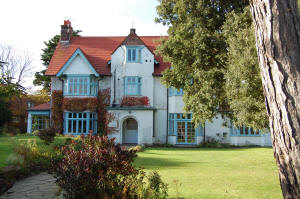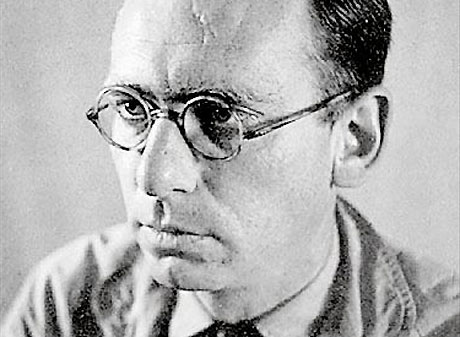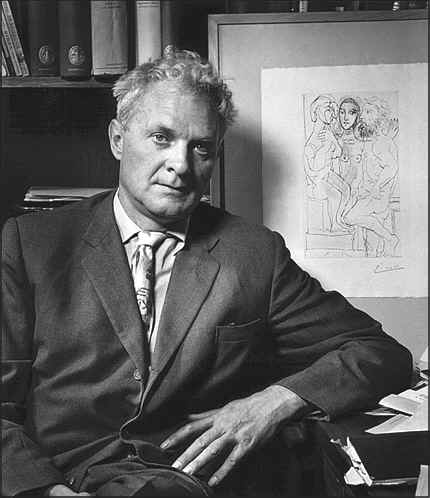Sheringham
Sheringham lies on the North Norfolk coast between
Weybourne and
West Runton. Originally it was a small fishing community -
but after the railway arrived in the late 19th Century it
flourished as a holiday resort.

Martincross, Sheringham |
|
Patrick Hamilton (1904-62)
The playwright and novelist Patrick Hamilton lived in the
town for many years. He was famous for his play Rope
which was later filmed by Alfred Hitchcock and for novels
such as The Slaves of Solitude, Hangover Square and
20,000 Streets Under the Sky.

Patrick Hamilton
However, by the end of his life his work had fallen out of fashion
and his drink problem had become critical. He died on
September 23, 1962 from cirrhosis of the liver (aged 58) in a flat at Martincross on the corner of
the Boulevard and St. Nicholas Place - which he shared with
his wife Lady Ursula Chetwynd-Talbot (also known as 'La').
She recorded in her journal:
|
|
'I got into a dressing gown, listened to P's breathing, then
went into the kitchen, snatched a biscuit and cheese, washed
up the tea, too tensed to sit and do nothing, then went to
listen to P. again - there was silence.' |
|
He was cremated and his ashes were scattered at
Blakeney. J. B. Priestley described him as 'an unhappy man
who needed whiskey as a car needs petrol'.
In 1919, the composer Ralph Vaughan Williams lived and
worked at Martincross; it was here that he wrote his 'Sea
Symphony'. |
|
Stephen Spender (1909-95)
The poet Stephen Spender (1909-1995) used to spend his
holidays in Sheringham. His family leased a house on the
cliffs here called 'The Bluff' and Spender was greatly
inspired by the nature and landscape of the area.

Stephen Spender
He recalls it fondly in his autobiography World Within World
(1953):
|
|
'We lived at Sheringham in Norfolk, where we had a house at
the extreme edge of the town on the cliffs and adjoining
fields. My childhood was the nature I remember: the
thickness of the grass in the pasture fields, amongst whose
roots were to be found heartsease (the small pansies which
are the colour of the iris in a golden eye), speedwell of a
blue as intense as a bead of sky. There were scabious and
cornflower and waving grasses and bracken which came as high
as my shoulders.' |
Later he attended Gresham's School near
Holt - where W.H. Auden was also a
pupil. |
|
Magdalen Goffin (1925 -
Another literary 'shannock' is the biographer Magdalen
Goffin who was born in the town. In 2006 she published a
biography of her father E.I. Watkin entitled: The Watkin
Path - An Approach to Belief. Watkin, who was a
influential theologian and historian, designed and built his
own house in the town (St. Mary's) - which still stands
today. She had previously written a biography of her grand
mother Maria Pasqua - who was taken from Italy by her father
on a tour of Europe and subsequently inspired painters in
Paris before being 'bought' by an English Countess. Maria
later married a Norfolk doctor called Philip Shepheard and
lived at both Gayton and Erpingham.
Allan Smethurst (1927-200)
Sheringham was also the childhood home of Allan Smethurst
- aka the Singing Postman.
He lived at 48, Cliff Road for many years and, later in
life, received a three year probation sentence for banging
on the door of the house while drunk and refusing to leave.
Trains etc
The Great Eastern Railway Line, which opened in 1883,
brought many Victorians to the North Norfolk coast -
including Clement Scott. Scott, who was a theatre critic
and writer, helped to popularise the area by referring
to it as 'Poppyland'. The Sheringham to Holt section of the line was closed
during the Beeching cuts of the 1960s - but was
reopened by volunteers in 1975. It is now
commonly known as 'The Poppy Line' - although poppies
are less evident these days due to the use of modern herbicides.
|
Links:
More photographs of Sheringham |

